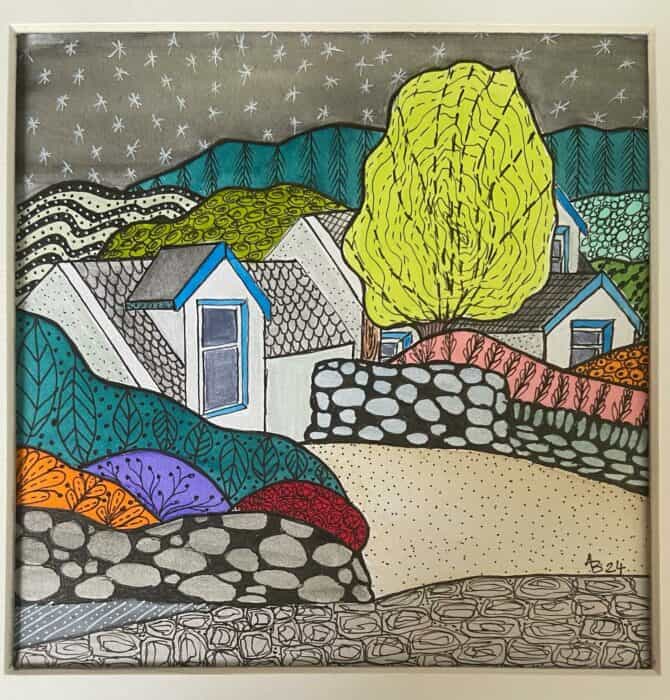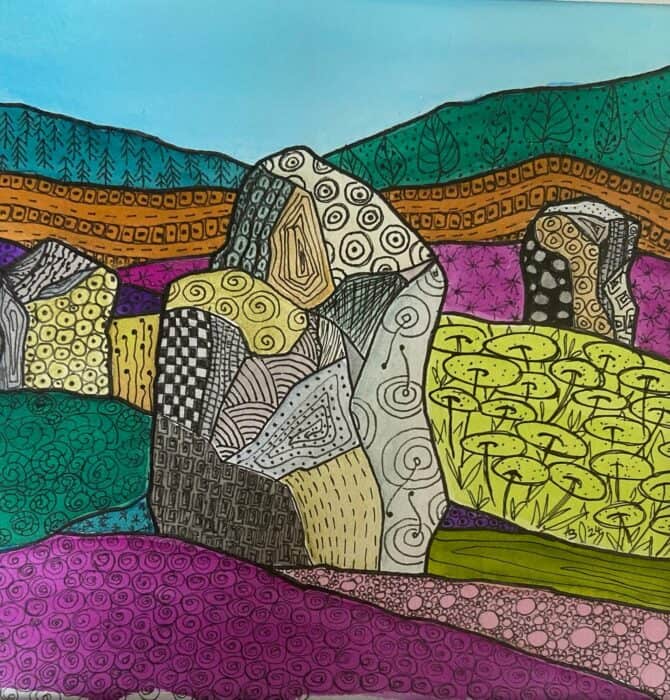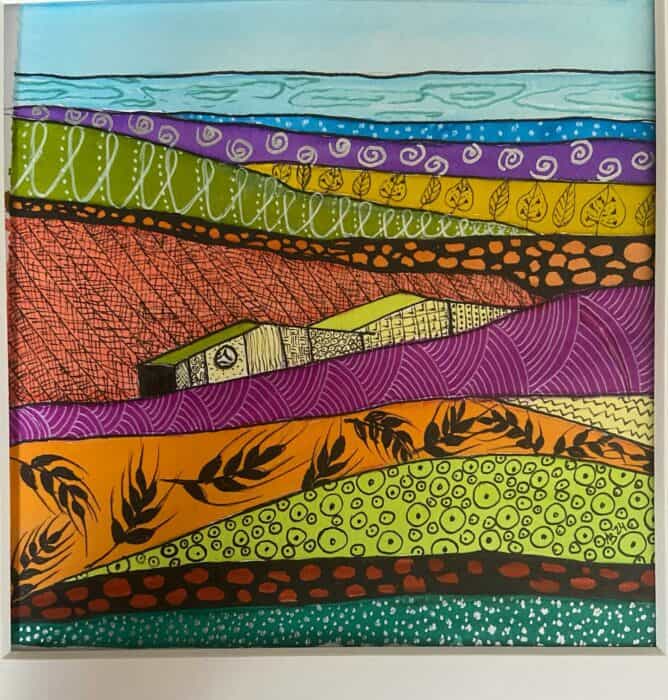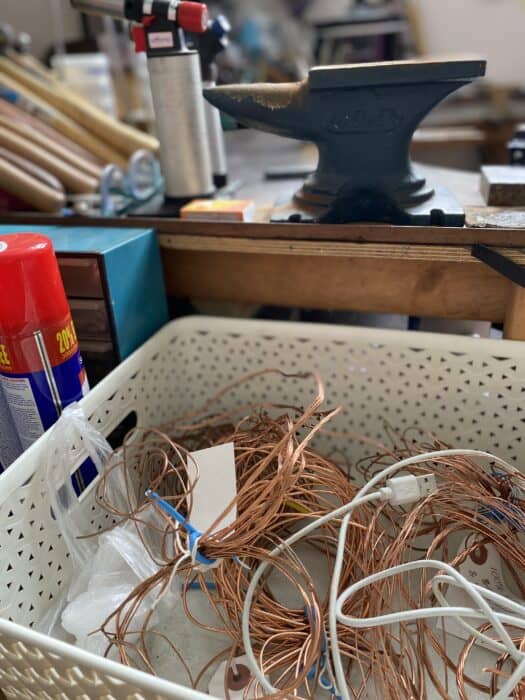Inspired by Arran’s patterns, textures and history, Arran Open Studios jeweller and painter Assja Solveiga Baumgärtner-Gaile plays with technique in creations made of sea glass, recycled silver and old electric wires, discovers writer Emily Rose Mawson.
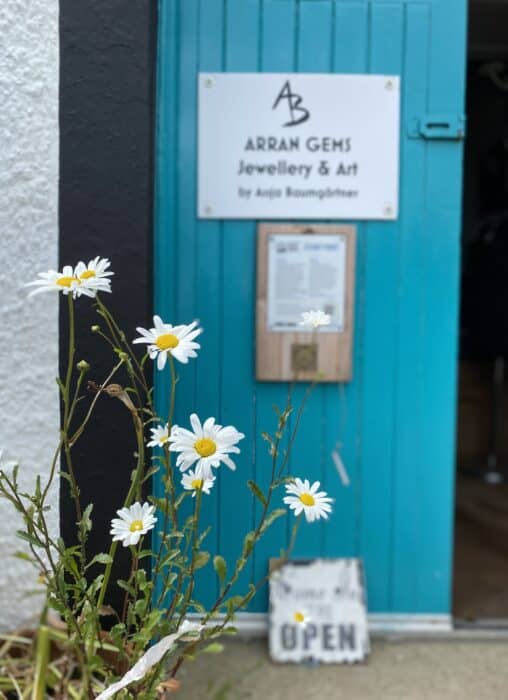
It’s a perfect spring day, the kind with puffy clouds and sun-dappled hawthorn blossom, when I drive the coast road 30 minutes south and west from Brodick to Kilmory. The scenery becomes increasingly quiet as Arran’s bigger villages dissolve into quilts of green fields tossed at whim towards the sea, the occasional farm a blot of white.
The studio I’m looking for is “behind the turquoise door” in the village hall, according to instructions from artist Assja Solveiga Baumgärtner-Gaile, and behind it, I stumble into a corridor filled with colour: a painting of Machrie Moor standing stones against the Aurora Borealis, a necklace made from upcycled tartan scraps and agate beads, and sea glass pendants wrapped in coils of wire.
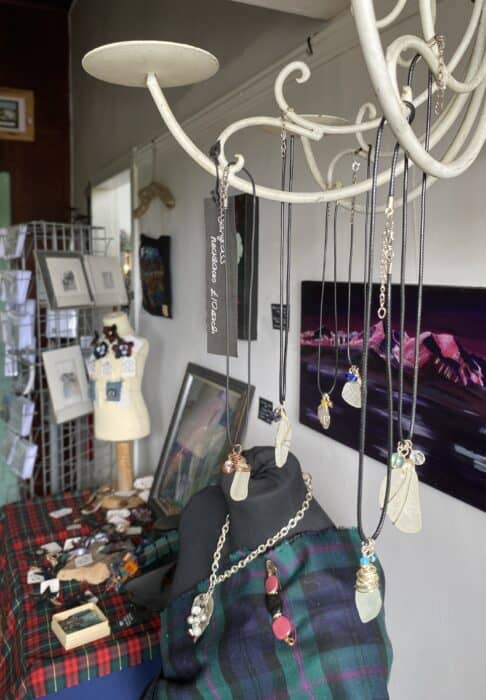
“I’m basically a very curious person. I want to play,” Assja tells me, herself dressed in glorious raspberry pink. “I like to explore and find out… and read up. As you go, you find out things that inspire you further.” Her initial inspiration comes from her surroundings – remnants of ancient history, the forest and the beach, which is reached by a path through wildflower-speckled woodland. She loves to sit on the rocks and watch the sea – “I could do that for days” – as well as beachcomb.
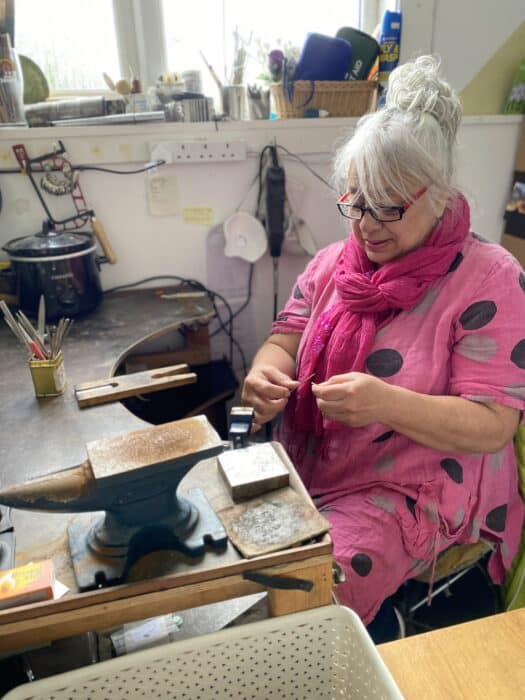
It was sea glass found in Kilmory that initiated her creative work. “I realised I couldn’t have bowls and bowls of it lying around the house,” explains Assja. So she wrapped wire around it so you could attach a chain, then she tried drilling a hole, and eventually she set some pieces in silver. She’s entirely self-taught, with techniques drawn from her love of experimenting and playing.The collection extends to necklaces inspired by dry stone walls and their “structure, lichens and ecosystems”, and exquisite copperwork pieces that play with texture, as well as landscapes in cheerful brights and delicately printed coasters that nod to blackwork embroidery. On the desk is a set of four Kilmory designs Assja has just finished: Ailsa Craig, the mushroom-shaped island that lingers on the horizon; Auchenleffen stone circle in Kilmory’s forest; nearby Lagg Distillery, named ‘Distillery of the Year 2023’ at the Scottish Whisky Awards; and Clachaig Cottage, “where the excise man once lived”.
SET OF 4 DESIGNS READY TO BE MADE INTO COASTERS
It all started with a box of beads that her mother gave her on her first day of school – “ugly plastic beads which I thought were absolutely gorgeous as a kid” – and a tin of colours, the sort Switzerland is known for. It was here that she grew up, and where she worked as a journalist before moving to Arran 30 years ago. Her mum is Latvian and her Dad, Indonesian, so home, she says, is difficult to pin down. “I never had the time to get roots until I moved here,” says Assja. “Arran is the longest time I’ve lived anywhere. So landscapes tend to feel close – the forest, lakes and sea. We have it all here, and mountains as well.”
As I glance around the studio, cool spring light splashes through high windows and it’s so still that the buzz of a solo fly seems amplified. My eyes are repeatedly drawn to the wooden cross Assja created for Arran Art Trail, based on the work of Scottish artist Craigie Aitchison. It is studded with silver balls and lines etched in gold and copper, all representing features of Arran’s landscape – blossom, mountains, birds and rivers. It is totally recycled, Assja tells me. “The silver balls from discarded silver jewellery, and the cross from the staves of a whisky barrel.”
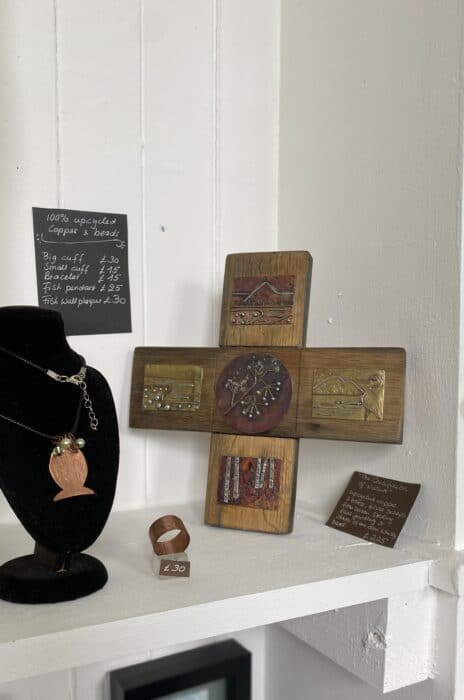
Wooden cross based on the work of Scottish artist Craigie Aitchison.
Her work, she says, is becoming increasingly sustainable. She uses recycled silver, and instead of jewellery wire, old electric wire. “And people bring me copper mirror frames, old household things that I can cut apart and turn into bangles and so on,” she says. One of her favourite pieces – “The Moon over Machrie Moor”, in copper and labradorite – uses a piece of bog oak she was given by the Corrie-based sculptor Marvin Elliott “years ago”
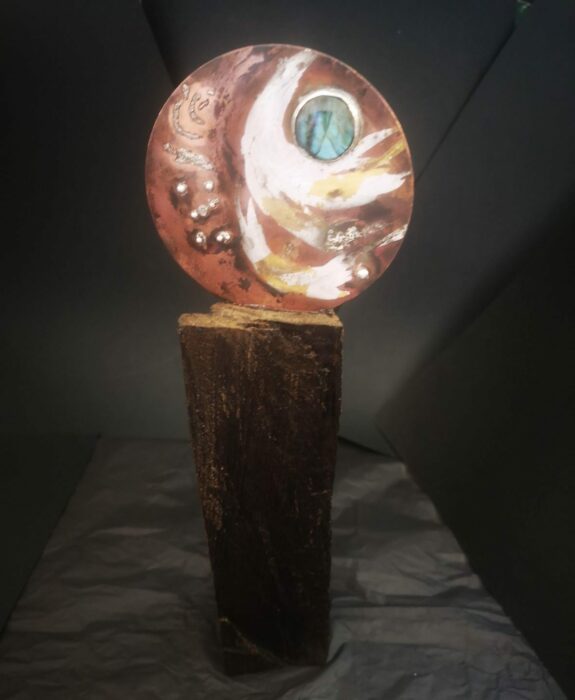
“The Moon over Machrie Moor”, in copper and labradorite – uses a piece of bog oak she was given by the Corrie-based sculptor Marvin Elliott “years ago”.

Bangle inspired by dry stone dyke.
For visitors who make the trip to Kilmory, she recommends making a day of it. The hall is at the start of an easy trail to the beach, which you can walk along for miles at low tide, and there are networks of paths in the woods. “If you have a car, or want to walk eight miles, the standing stones in Auchenleffen are worthwhile. And the forestry tracks are wonderful.” I wonder where her favourite place is? “If you have a favourite place, it’s you and the place, so you don’t want too many people to know about it,” she says with a smile. “But I just love forests and going into the forest.”
As I leave, back through the turquoise door, a couple have just arrived and are gushing with praise for Assja’s work. “Oh, this one’s beautiful,” I hear. And I smile to think of this self-taught talent tucked away in Arran’s remote southwest. As I drive north and east, returning to Brodick, my eyes are irresistibly drawn over the fields to the sea, but this time I see the view in Assja’s colours.
About Arran Open Studios
Arran Open Studios is an annual initiative incorporating painters, sculptors and craftspeople from the Isle of Arran. Launched in 2012, it operates under the umbrella arts charity the Arran Theatre and Arts Trust. This year, it takes place from 16-19 August.
